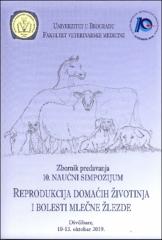| dc.description.abstract | Implementation of A.I. in the pig industry allows introduction of superior genes
for highest meat production or fertility, and thus allowing maximal profitability
from boars of the best genetic potential. The risk of disease spreading by direct
contact among animals is reduced by introduction of artificial insemination techniques
of sows, but at the same time, there is condition created for “an mass” propagation
of pathogenic microorganisms by semen used for AI of sows and gilts
(Maes et al., 2008). Porcine reproductive-respiratory syndrome (PRRS) is an actual
viral disease of pigs provoking serious health problems and major economic damages
across the world and as well in R. of Serbia (Avakumović, 2006). Due to
the significant pig losses, certain preventive measures are implemented, including
vaccination of pigs in the infected farms (Zuckermann et al, 2007). Former scientific
papers mainly refers to the effects of vaccine in piglets and gilts. Prieto et al.
(1994) reported a decrease in sperm quality in infected boars and those vaccinated
with modified live vaccine(INGELVAC®,PRRS,MLV).
This article describes boars’ semen quality before and after vaccination with
Porcilis PRRS vaccine (Intervet International BV, The Netherlands). Semen quality
was examined by semen computer analysis (CASA), by integrated software
system for the analysis of sperm cells (ISAS; Proiser, Valencia, Spain).
Average total sperm motility and progressive motility for 29 boars in the period
prior to vaccination was 62.6% and 43.9%, respectively. The quality of sperm
after vaccination significantly declined to 43.6% and 30.2%, respectively (p<0,05;
t-test). Semen quality reduction after PRRS vaccination of boars was also described
by Christopher-Hennings et al. (1997). | en_US |

